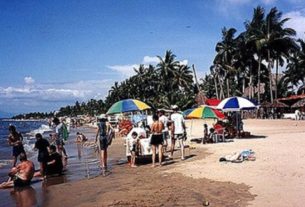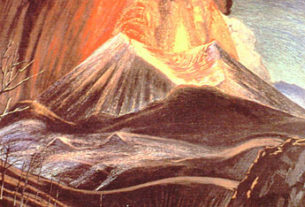Sayula
After having read an article in the local Guadalajara Reporter by a man who retired in Sayula, some friends and I decided to check it out. It’s a nice-sized town with a population of about 200,000, located about 1-1/2 hours from Ajijic towards Colima. The central plaza is large and full of benches and shade trees. At the plaza is a beautiful church and a museum which was closed on Wednesdays, so we missed that.
More interesting to us though, was the knife maker, the fifteenth generation of his family to be in the business in Sayula. Jose Ojeda’s shop was small, located about three blocks from the center of town, at Daniel Larios #23. The front room is full of knives for sale, from paring knives to machetes. All are made from fine German, French and Swedish steel. Over the generations, the Ojedas’ knives have been discovered by hunters, gardeners and collectors worldwide.
The earliest generations of Ojedas forged shields and lances for the Spanish Army when they left Barra de Navidad to conquer the Phillipines.
Some of the hand carved handles and etched blades are true works of arts. I was amused at the leather belts, with hidden pockets which hide a sleek steel stiletto attached to the buckle.
I bought one paring knife, one butcher knife, and a wonderful sharpener. I have no idea what it’s called, but you’ve seen them — long thin cylindrical files, made of the finest German steel. Maybe now, I’ll start slicing, dicing and cooking.
Zapotlanejo
Last week a friend and I decided to visit two northern suburbs of Guadalajara. Several artisans who had been at the art expo in Tlaquepaque had stores in Zapopan and Zapotlanejo. I wanted to order a custom cabinet of pounded, rusted, and varnished metal similar to one I had seen at the expo.
Armed with map and address, we headed off in pursuit. The metal furniture place was located between Zapotlanejo and Tonala, behind blue iron gates that looked like they led to a cement yard. There was no bell and no sign. Bravely, I rattled the iron gates until I heard a small child. Eventually a Mexican woman opened the gates.
“Muebles para vender?” I asked in my best Spanish, hoping she’d understand my inquiry as to whether or not they sold furniture.
“Sí, pásele,” she responded, inviting us to come in. In the front yard, under tarps, sat women and children fixing lunch. In the back, extending for at least a city block was an outdoor manufacturing facility for exquisite wooden and metal furniture. ‘Manufacturing facility’ is used casually, since all work is done by hand.
“Ahorita, ahorita,” said the Mexican woman as she scurried away. We weren’t sure what we were waiting for until a nice looking Mexican man returned and asked in passable English, “May I help you?”
He took my measurements (not mine, those of my custom cabinet), quoted me $200 and asked for a $100 dollar deposit. He gave me a hand written receipt and said the cabinet would be ready in a month. We agreed on the hardware and a 150 peso delivery charge.
“Do you think you’ll get it?” Asked my friend.
“Yes.” I’m always thinking positive, although I never did get a fountain I had ordered and paid for in Dolores Hidalgo.
We watched the men ‘rusting’ various metal objects. They simply poured water over them and let Mother Nature do the work. There were six-foot high metal ostriches, smaller roosters, and chickens either rusted ‘au natural’ or coated with varnish. They’d be perfect for a garden.
Zapopan
My friend Betty and I headed for Zapopan and lunch. On the way, we discovered the Plaza Patria. Since I prefer my days to unfold rather than committing to a predetermined schedule, we decided shopping in a western style mall wasn’t out of the question. Besides, Sandy’s restaurant was in the mall and we were both hungry. One of my surprise discoveries was a GNC store with all the vitamins and minerals I could ask for. The prices were about 10% higher than in the states, but I was willing to pay that, rather than rely on friends to bring them down.
After lunch, we went in search of another artisan. Drat! We forgot about the dreaded siesta time. It was closed as would other small businesses be between the hours of two and four, so we headed to the town square in Zapopan.
The tile-domed, seventeenth-century franciscan Basilica de Zapopan is home to the famous Virgin of Zapopan, the patron saint of Guadalajara. I’ve seen her twice on her caravans — once in Guadalajara and once in Ajijic. When she travels, she rides in what I call a virgin-mobile. She is 13″ high, and stands at the rear window of a large black van where she is followed in the street by worshippers, musicians and assorted parade participants. The homes along her route are decorated with blue and white crepe paper.
Her return to Zapopan from her yearly journey to all the churches of the Diocese, is marked by a huge celebration on October 12. The procession is a five-hour journey of the virgin from the cathedral of Guadalajara to the cathedral of Zapopan.
The exterior of the Basilica is designed in the Doric colonial style. Interior decorations are blue and white, the colors of Our Lady of Zapopan. Huge marble columns and an exquisite altar are lavishly ornamented with gold leaf. The sun shining through the stained glass windows in the large dome, dances around the Virgin who is enthroned in a glass case high above the altar.
We stood respectfully at the side of the church watching men, women and children of all ages walk on their knees the entire length of the cathedral to the front of the altar. The faithful are either asking for a miracle or thanking the Virgin de Zapopan for one already given.
I thought about following suit, for the miracle of getting a major publisher to pick up my book, but decided she probably didn’t have much practice with that kind of miracle!


